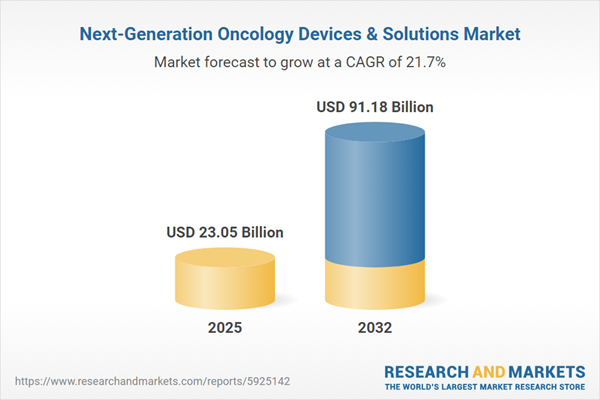Speak directly to the analyst to clarify any post sales queries you may have.
The next-generation oncology devices and solutions market is undergoing rapid changes, driven by unprecedented advances in diagnostics, imaging, and therapeutic delivery. Industry transformation is accelerating as digital technologies, innovative care models, and shifting global dynamics reshape opportunities for stakeholders across the cancer care ecosystem.
Market Snapshot: Next-Generation Oncology Devices & Solutions Market Overview
The Next-Generation Oncology Devices & Solutions Market grew from USD 18.97 billion in 2024 to USD 23.05 billion in 2025. It is expected to continue growing at a CAGR of 21.67%, reaching USD 91.18 billion by 2032.
Scope & Segmentation: Comprehensive Market Landscape
This report provides a thorough view of the next-generation oncology devices sector, examining product channels, clinical applications, and commercial avenues. Segmentation covers a wide spectrum of device types, technological approaches, cancer types, end-user categories, and key regional markets.
- Device Type: Diagnostic devices such as fluorescence in situ hybridization, immunohistochemistry, next generation sequencing (including exome sequencing, targeted panels, and whole genome sequencing), polymerase chain reaction (with digital and quantitative PCR), imaging devices (CT including cone beam and multi-slice, MRI with 1.5T and 3T, PET/CT and PET/MRI hybrids, ultrasound with 2D and 3D/4D, and X-ray including computed and digital radiography), monitoring devices (biosensors and wearables), surgical devices (cryosurgery, laparoscopic, and robotic surgery), and therapeutic devices (drug delivery systems and radiation therapy including brachytherapy systems, linear accelerators, and proton therapy systems).
- Technology: Artificial intelligence (data analytics, deep learning, and machine learning), bioinformatics (NGS and proteomics data analysis), digital pathology (image analysis software, whole slide imaging), nanotechnology (nanocarriers, nanodiagnostics), and robotics (biopsy and surgical applications).
- Cancer Type: Breast, colorectal, lung, and prostate cancer applications are focal points of innovation and product development.
- End User: Major adopters include ambulatory care centers, diagnostic laboratories, hospitals, and research institutes facilitating clinical integration and early-stage evaluation.
- Regions: Market coverage spans the Americas (inclusive of North and Latin America), Europe, Middle East & Africa, and Asia-Pacific, detailing country-level perspectives across diverse healthcare and regulatory environments.
- Key Companies: The report assesses strategies and developments from Siemens Healthineers AG, General Electric Company, Koninklijke Philips N.V., Accuray Incorporated, Ion Beam Applications S.A., Brainlab AG, ViewRay, Inc., Mevion Medical Systems, Inc., and RaySearch Laboratories AB.
Key Takeaways for Senior Decision-Makers
- Next-generation oncology devices are transforming early detection, patient stratification, and targeted therapy strategies, empowering providers to deliver precision oncology at scale.
- Stakeholders, including device manufacturers, regulatory bodies, and healthcare payers, face both operational and strategic shifts as technology drives new care models and real-time data integration.
- Diagnostic, digital, and surgical innovations are accelerating clinical workflows, minimizing treatment-related morbidities, and supporting a move toward personalized cancer care pathways.
- Strategic alliances—such as mergers, licensing, and partnerships—are central to competitive positioning, fostering rapid clinical adoption and portfolio diversification.
- Regulatory, manufacturing, and reimbursement decisions are increasingly influenced by the integration of artificial intelligence, regional manufacturing trends, and evolving value-based care frameworks.
Tariff Impact: Navigating Trade and Supply Chain Volatility
Proposed United States tariffs in 2025 introduce greater complexity to global oncology device supply chains. Many vital components, such as biosensors and imaging detectors sourced from Asia and Europe, face rising production costs due to these measures. Manufacturers are adjusting sourcing and production strategies, potentially increasing infrastructure and operational expenditures. Simultaneously, downstream purchasing cycles and equipment budgets of hospitals and ambulatory centers may be affected. Industry dialogue continues around regulatory mitigation and potential tariff exemptions to sustain innovation momentum.
Methodology & Data Sources
Insights in this report are based on multi-source data collection, in-depth expert interviews, and thorough validation processes. Primary research captured the viewpoints of oncologists, engineers, and regulatory specialists, while secondary research analyzed regulatory filings, financial disclosures, and literature. Analytical frameworks stress data triangulation and peer review for accuracy and reliability.
Why This Report Matters
- Provides executive-level guidance for capital allocation and investment prioritization in oncology devices and solutions.
- Equips strategy teams to proactively address regulatory shifts, supply chain risks, and disruptive competitor moves.
- Enables product, commercial, and R&D leaders to identify growth frontiers, partnership opportunities, and technology integration pathways.
Conclusion
The next-generation oncology devices market is evolving rapidly, requiring informed navigation of technological, regulatory, and operational dynamics. Decision-makers equipped with this analysis are positioned to capitalize on innovation, enhance patient outcomes, and achieve sustained market leadership.
Additional Product Information:
- Purchase of this report includes 1 year online access with quarterly updates.
- This report can be updated on request. Please contact our Customer Experience team using the Ask a Question widget on our website.
Table of Contents
3. Executive Summary
4. Market Overview
7. Cumulative Impact of Artificial Intelligence 2025
Companies Mentioned
The companies profiled in this Next-Generation Oncology Devices & Solutions market report include:- Siemens Healthineers AG
- General Electric Company
- Koninklijke Philips N.V.
- Accuray Incorporated
- Ion Beam Applications S.A.
- Brainlab AG
- ViewRay, Inc.
- Mevion Medical Systems, Inc.
- RaySearch Laboratories AB
Table Information
| Report Attribute | Details |
|---|---|
| No. of Pages | 183 |
| Published | October 2025 |
| Forecast Period | 2025 - 2032 |
| Estimated Market Value ( USD | $ 23.05 Billion |
| Forecasted Market Value ( USD | $ 91.18 Billion |
| Compound Annual Growth Rate | 21.6% |
| Regions Covered | Global |
| No. of Companies Mentioned | 10 |









